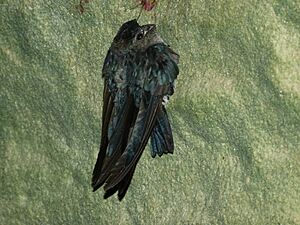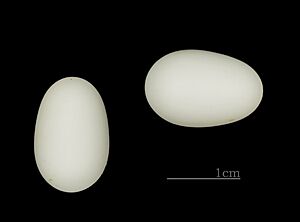Glossy swiftlet facts for kids
Quick facts for kids Glossy swiftlet |
|
|---|---|
 |
|
| Conservation status | |
| Scientific classification | |
| Genus: |
Collocalia
|
| Species: |
esculenta
|
| Synonyms | |
|
Hirundo esculenta Linnaeus, 1758 |
|
The glossy swiftlet (Collocalia esculenta) is a small, fast-flying bird that belongs to the swift family. These birds are known for their quick flight and often live in caves. You can find them in places like the Indonesian island of Sulawesi, New Guinea, the Bismarck Archipelago, and the Solomon Islands.
Contents
About the Glossy Swiftlet
The glossy swiftlet was first described by a Swedish scientist named Carl Linnaeus in 1758. He gave it the scientific name Hirundo esculenta. The word esculenta comes from a Latin word meaning "edible." This bird has many different types, called subspecies, that live in various locations.
Scientists have recently studied these swiftlets very closely. Because of this, some birds that were once thought to be types of the glossy swiftlet are now considered their own separate species. These include:
- Plume-toed swiftlet (Collocalia affinis)
- Grey-rumped swiftlet (Collocalia marginata)
- Ridgetop swiftlet (Collocalia isonota)
- Tenggara swiftlet (Collocalia sumbawae)
- Drab swiftlet (Collocalia neglecta)
- Satin swiftlet (Collocalia uropygialis)
- Christmas Island swiftlet (Collocalia natalis)
What Does It Look Like?
The glossy swiftlet has shiny black-blue feathers on its back and head. Its chest is black, and its belly and sides are white with small black spots. Its wing tips are rounded, and the underside of its wings is black. The tail is rounded with a small dip and tiny white patches.
This bird is about 9 to 11.5 centimeters (about 3.5 to 4.5 inches) long. It looks very similar to the white-rumped swiftlet. To tell them apart, you often need to see both the top and bottom of the bird. Its voice is a soft, chattering sound.
Behaviour and Life Cycle
Glossy swiftlets build their nests inside caves and buildings. They make their nests on vertical walls or under flat surfaces. They use a sticky gel they produce and attach string-like grass to create their nests.
You can often see these birds flying over forests, streams, rivers, and roads. They catch insects while flying, which is how they get their food.
Scientists have even thought about using glossy swiftlets to help other endangered birds. They considered them as possible "foster parents" to help increase the number of edible-nest swiftlets in the Andaman Islands.
Where Do They Live?
The glossy swiftlet is found in many places. These include Indonesia, Timor, Brunei, Christmas Island, the Philippines, Papua New Guinea, the Solomon Islands, Vanuatu, and New Caledonia. Sometimes, a few might fly to Australia, but they don't usually live there. These birds do not migrate, meaning they don't travel long distances for different seasons.
Conservation Status
The glossy swiftlet is quite common in most of the areas where it lives. It doesn't face any major threats right now. Because of this, the IUCN (International Union for Conservation of Nature) has listed it as a species of "Least Concern." This means they are not worried about it becoming endangered anytime soon.



